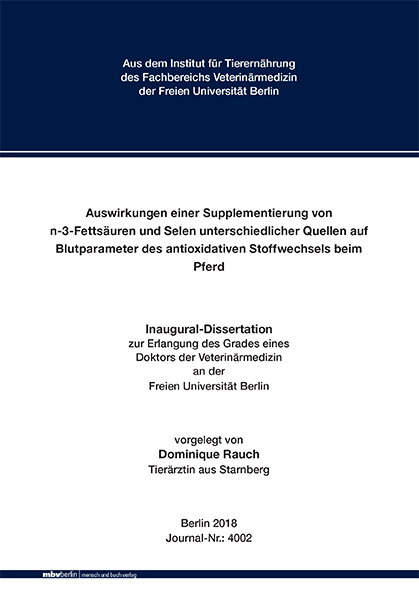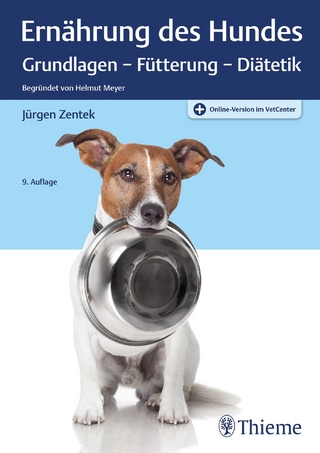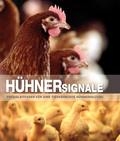
Auswirkungen einer Supplementierung von n-3-Fettsäuren und Selen unterschiedlicher Quellen auf Blutparameter des antioxidativen Stoffwechsels beim Pferd
Seiten
2018
|
1. Aufl.
Mensch & Buch (Verlag)
978-3-86387-891-7 (ISBN)
Mensch & Buch (Verlag)
978-3-86387-891-7 (ISBN)
- Keine Verlagsinformationen verfügbar
- Artikel merken
Effects of supplementation with n-3-fatty-acids and selenium from different sources on blood parameters of the antioxidant metabolism in horses
The aim of the study was to examine how a supplementation of fatty-acids in linseed oil and selenium from different sources (Na-selenite vs. selenium yeast) on parameters of the antioxidant metabolism in young thoroughbred horses. A randomized feeding experiment on 19 thoroughbred yearlings with linseed oil (320 mg / kg BM / day) and selenium from different sources (selenium yeasts, Na-selenite; dosage: 0.5 mg / kg DM) was conducted throughout three experimental phases. The fatty acid pattern in the plasma was determined by gas chromatography. The concentration of selenium in the blood serum was investigated by atomic absorption spectrometry. The parameters of the antioxidant metabolism (TEAC, GSH, GPx) were measured photometrically. For a statistical evaluation, the data was tested for normal distribution, a t-test or analysis of variance was applied.
The supplementation with linseed oil has been proven to lead to a change of the concentration of fatty-acids in the plasma but did not cause an enrichment of n3:n6-ratio. The supplementation of selenium induced an increase of the selenium concentration in the blood; selenium yeast lead to an increase of 75% while the blood values of animals fed with Naselenite showed an increase of 44.5%. Regardless of the selenium source, the addition of selenium caused higher TEAC values in the blood plasma (p < 0.01).
Throughout the experiment the concentration of glutathione in the erythrocytes lysate was not influenced. The activity of GPx increased after the supplemented period by 9.67% and after four more weeks again by 19.9% (p < 0.001).
Adding linseed oil to the feed in a dosage of 320 mg / kg BM / day seems not to be suitable to affect fatty acid metabolism in horses; according to literature references, feeding oils of marine origin or oils made of microalgae caused an efficient enrichment of polyunsaturated fatty acids in the blood plasma and blood cells of horses. Studies under performance condition seem to be useful for a better interpretation of the effects of a high-fat diet on the antioxidant system.
It would be interesting to find out how and in which way a diet with antioxidants given to sports horses could influence their performance capacity positively. Auswirkungen einer Supplementierung von n-3-Fettsäuren und Selen unterschiedlicher Quellen auf Blutparameter des antioxidativen Stoffwechsels beim Pferd
Ziel der vorliegenden Studie war, die Auswirkungen einer Supplementierung von Fettsäuren aus Leinöl und Selen unterschiedlicher Quellen (Na-Selenit vs. Selenhefen) auf Parameter des antioxidativen Stoffwechsels bei jungen Vollblütern zu untersuchen. An 19 Vollblut-Jährlingen wurde ein randomisierter Fütterungsversuch mit Leinöl (320 mg / kg KM / Tag) und Selen unterschiedlicher Bindungsformen (Selenhefen, Na-Selenit; Dosierung: 0,5 mg / kg TS) über drei Versuchsphasen durchgeführt. Das Fettsäuremuster des Plasmas wurde mittels Gaschromatographie ermittelt, der Selengehalt des Blutserums wurde durch Atomabsorptionsspektrometrie bestimmt. Die Parameter des antioxidativen Stoffwechsels (TEAC, GSH, GPx) wurden photometrisch gemessen. Nach Prüfung der Daten auf Normalverteilung wurde der t-Test für unabhängige Stichproben und die Varianzanalyse bei wiederholten Messungen abhängiger Stichproben zur statistischen Auswertung herangezogen.
Die Supplementierung mit Leinöl führte zu nachweislichen Veränderungen der Konzentrationen von Fettsäuren im Plasma, allerdings nicht zu einer nennenswerten Anreicherung von n-3-FS. Die Supplementierung von Selen induzierte einen Anstieg der Selenkonzentration im Blut. Dabei führte Selenhefe zu einer Zunahme der Selenkonzentration um 75%, während die Blutwerte bei Tieren, die Na-Selenit erhielten, um 44,5% anstiegen.
Die Zulage von Selen führte –unabhängig von der verabreichten Selenquelle- zu höheren TEAC-Werten im Blutplasma (p< 0,01). Die Konzentration von Glutathion im Erythrozytenlysat wurde im Verlauf des Versuches nicht beeinflusst. Die Aktivität der GPx stieg nach der Versuchsphase um 9,67% und nach weiteren vier Wochen um erneute 19,9% an (p< 0,001).
Die Verwendung von Leinöl in einer Dosierung von 320 mg /kg KM /Tag war nicht geeignet, die Konzentration der n-3-FS im Organismus des Pferdes deutlich zu beeinflussen. Im Gegensatz dazu führte die Gabe von Ölen marinen Ursprungs oder auch von Mikroalgen nach Literaturangaben zu einer effizienteren Anreicherung von mehrfach ungesättigten Fettsäuren in Blutplasma und –zellen des Pferdes. Um die Effekte einer fettreichen Diät auf Parameter des antioxidativen Systems und in Folge auf das Leistungsvermögen besser beurteilen zu können, scheinen Studien unter Leistungsbedingungen sinnvoll.
The aim of the study was to examine how a supplementation of fatty-acids in linseed oil and selenium from different sources (Na-selenite vs. selenium yeast) on parameters of the antioxidant metabolism in young thoroughbred horses. A randomized feeding experiment on 19 thoroughbred yearlings with linseed oil (320 mg / kg BM / day) and selenium from different sources (selenium yeasts, Na-selenite; dosage: 0.5 mg / kg DM) was conducted throughout three experimental phases. The fatty acid pattern in the plasma was determined by gas chromatography. The concentration of selenium in the blood serum was investigated by atomic absorption spectrometry. The parameters of the antioxidant metabolism (TEAC, GSH, GPx) were measured photometrically. For a statistical evaluation, the data was tested for normal distribution, a t-test or analysis of variance was applied.
The supplementation with linseed oil has been proven to lead to a change of the concentration of fatty-acids in the plasma but did not cause an enrichment of n3:n6-ratio. The supplementation of selenium induced an increase of the selenium concentration in the blood; selenium yeast lead to an increase of 75% while the blood values of animals fed with Naselenite showed an increase of 44.5%. Regardless of the selenium source, the addition of selenium caused higher TEAC values in the blood plasma (p < 0.01).
Throughout the experiment the concentration of glutathione in the erythrocytes lysate was not influenced. The activity of GPx increased after the supplemented period by 9.67% and after four more weeks again by 19.9% (p < 0.001).
Adding linseed oil to the feed in a dosage of 320 mg / kg BM / day seems not to be suitable to affect fatty acid metabolism in horses; according to literature references, feeding oils of marine origin or oils made of microalgae caused an efficient enrichment of polyunsaturated fatty acids in the blood plasma and blood cells of horses. Studies under performance condition seem to be useful for a better interpretation of the effects of a high-fat diet on the antioxidant system.
It would be interesting to find out how and in which way a diet with antioxidants given to sports horses could influence their performance capacity positively. Auswirkungen einer Supplementierung von n-3-Fettsäuren und Selen unterschiedlicher Quellen auf Blutparameter des antioxidativen Stoffwechsels beim Pferd
Ziel der vorliegenden Studie war, die Auswirkungen einer Supplementierung von Fettsäuren aus Leinöl und Selen unterschiedlicher Quellen (Na-Selenit vs. Selenhefen) auf Parameter des antioxidativen Stoffwechsels bei jungen Vollblütern zu untersuchen. An 19 Vollblut-Jährlingen wurde ein randomisierter Fütterungsversuch mit Leinöl (320 mg / kg KM / Tag) und Selen unterschiedlicher Bindungsformen (Selenhefen, Na-Selenit; Dosierung: 0,5 mg / kg TS) über drei Versuchsphasen durchgeführt. Das Fettsäuremuster des Plasmas wurde mittels Gaschromatographie ermittelt, der Selengehalt des Blutserums wurde durch Atomabsorptionsspektrometrie bestimmt. Die Parameter des antioxidativen Stoffwechsels (TEAC, GSH, GPx) wurden photometrisch gemessen. Nach Prüfung der Daten auf Normalverteilung wurde der t-Test für unabhängige Stichproben und die Varianzanalyse bei wiederholten Messungen abhängiger Stichproben zur statistischen Auswertung herangezogen.
Die Supplementierung mit Leinöl führte zu nachweislichen Veränderungen der Konzentrationen von Fettsäuren im Plasma, allerdings nicht zu einer nennenswerten Anreicherung von n-3-FS. Die Supplementierung von Selen induzierte einen Anstieg der Selenkonzentration im Blut. Dabei führte Selenhefe zu einer Zunahme der Selenkonzentration um 75%, während die Blutwerte bei Tieren, die Na-Selenit erhielten, um 44,5% anstiegen.
Die Zulage von Selen führte –unabhängig von der verabreichten Selenquelle- zu höheren TEAC-Werten im Blutplasma (p< 0,01). Die Konzentration von Glutathion im Erythrozytenlysat wurde im Verlauf des Versuches nicht beeinflusst. Die Aktivität der GPx stieg nach der Versuchsphase um 9,67% und nach weiteren vier Wochen um erneute 19,9% an (p< 0,001).
Die Verwendung von Leinöl in einer Dosierung von 320 mg /kg KM /Tag war nicht geeignet, die Konzentration der n-3-FS im Organismus des Pferdes deutlich zu beeinflussen. Im Gegensatz dazu führte die Gabe von Ölen marinen Ursprungs oder auch von Mikroalgen nach Literaturangaben zu einer effizienteren Anreicherung von mehrfach ungesättigten Fettsäuren in Blutplasma und –zellen des Pferdes. Um die Effekte einer fettreichen Diät auf Parameter des antioxidativen Systems und in Folge auf das Leistungsvermögen besser beurteilen zu können, scheinen Studien unter Leistungsbedingungen sinnvoll.
| Erscheinungsdatum | 29.09.2018 |
|---|---|
| Verlagsort | Berlin |
| Sprache | deutsch |
| Maße | 148 x 210 mm |
| Themenwelt | Veterinärmedizin ► Allgemein ► Tierernährung / Tierhaltung / Tierzucht |
| Veterinärmedizin ► Pferd | |
| Schlagworte | antioxidant metabolism • antioxidativer Stoffwechsel • blood parameters • blood plasma • Blutwerte • Horses • Metabolism • Oxidation • Pferde • saturated fatty acids • selenium • unsaturated fatty acids |
| ISBN-10 | 3-86387-891-4 / 3863878914 |
| ISBN-13 | 978-3-86387-891-7 / 9783863878917 |
| Zustand | Neuware |
| Informationen gemäß Produktsicherheitsverordnung (GPSR) | |
| Haben Sie eine Frage zum Produkt? |
Mehr entdecken
aus dem Bereich
aus dem Bereich
Grundlagen - Fütterung - Diätetik Begründet von Helmut Meyer
Buch (2022)
Thieme (Verlag)
91,00 €
Praxisleitfaden für eine tiergerechte Hühnerhaltung
Buch | Softcover (2023)
Landwirtschaftsverlag Münster
44,80 €


